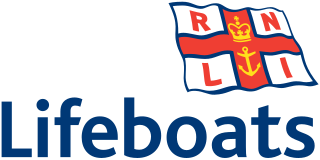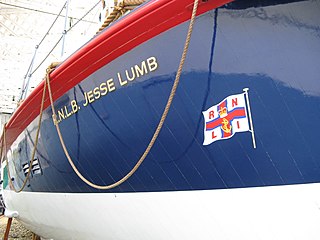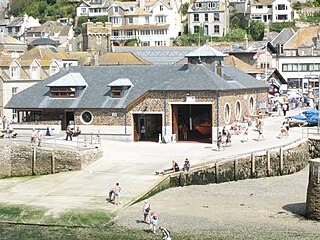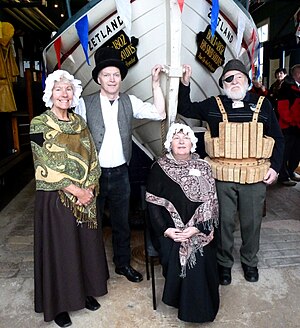
The Royal National Lifeboat Institution (RNLI) is the largest charity that saves lives at sea around the coasts of the United Kingdom, the Republic of Ireland, the Channel Islands, and the Isle of Man, as well as on some inland waterways. It is one of several lifeboat services operating in the same area.

The Penlee lifeboat disaster occurred on 19 December 1981 off the coast of Cornwall, England. The Royal National Lifeboat Institution (RNLI) lifeboat Solomon Browne, based at the Penlee Lifeboat Station near Mousehole, went to the aid of the vessel Union Star after its engines failed in heavy seas. After the lifeboat had rescued four people, both vessels were lost with all hands. Sixteen people died, including eight volunteer lifeboatmen.

The Wells lifeboat disaster occurred in 1880 when the RNLI lifeboat Eliza Adams, based at Wells-next-the-Sea in the English county of Norfolk, attempted to go to the aid of the stricken brig Ocean Queen in heavy seas and was lost along with 11 of its 13 crew.
Since its inception, the Royal National Lifeboat Institution (RNLI) has provided lifeboats to lifeboat stations in the United Kingdom and Ireland.

Henry Francis Greathead (1757–1818) was a pioneering rescue lifeboat builder from South Shields. Although Lionel Lukin had patented a lifeboat in 1785, Greathead successfully petitioned parliament in 1802 with the claim that he had invented a lifeboat in 1790, and he was awarded £1,200 for his trouble. Although his claims have been contested, he did build 31 boats, which saved very many lives, and succeeded in making the concept of a shore-based rescue lifeboat widely accepted.
A rescue lifeboat is a boat rescue craft which is used to attend a vessel in distress, or its survivors, to rescue crew and passengers. It can be hand pulled, sail powered or powered by an engine. Lifeboats may be rigid, inflatable or rigid-inflatable combination-hulled vessels.

Wells-next-the-Sea Lifeboat Station is a lifeboat station in the town of Wells-next-the-Sea in the English county of Norfolk. The station, run by the Royal National Lifeboat Institution, operates both inshore and offshore lifeboats. The inshore boat is a D-class (IB1) lifeboat named Peter Wilcox (D-707), whilst the offshore lifeboat is Shannon-class 13-46 named Duke of Edinburgh (ON 1161). The station boathouse is located at the beach on the western side of Wells Harbour mouth.
RNLB Aguila Wren is a retired Liverpool-class lifeboat of the Royal National Lifeboat Institution. She is currently being restored to her original RNLI condition, with work expected to be complete in 2017 or 2018. Aguila Wren was built as a memorial to 22 members of the Women's Royal Naval Service (WRNS) who were killed when their transport ship to Gibraltar, the Yeoward Line ship SS Aguila, was sunk by German submarine U-201 in the North Atlantic in 1941.

Sennen Cove Lifeboat Station is the base for Royal National Lifeboat Institution (RNLI) search and rescue operations for the sea around Land's End, Cornwall in the United Kingdom. The first lifeboat was stationed at Sennen Cove in 1853. Since 2009 it has operated a Tamar-class all weather boat (ALB) and a D-class (IB1) inshore lifeboat (ILB).

RNLB Jesse Lumb is a historic lifeboat. Built by J. Samuel White in 1939, Jesse Lumb served as the lifeboat at Bembridge on the Isle of Wight from 1939 to 1970, becoming the last of her type in service. Since 2000 she has been preserved at Classic Boat Museum, Cowes. In August 1999 she was inscribed on the National Register of Historic Vessels, becoming part of the National Historic Fleet.

RNLB Foresters Centenary is a retired Liverpool-class lifeboat of the Royal National Lifeboat Institution (RNLI), stationed in the English coastal town of Sheringham in the county of Norfolk in the United Kingdom. The lifeboat was on station for 25 years between 1936 and 1961 when she was sold. She has been restored to her original condition and is exhibited in Sheringham Museum.

RNLB Lucy Lavers was an RNLI lifeboat which was on No. 2 station at Aldeburgh from 1940 until 1959 when she was placed in the reserve fleet until 1968 when she was retired. The Rescue Wooden Boats Charity is currently undertaking restoration of the vessel. The Lucy Lavers is entered in the National Historic Ships register and has the Certificate No 2206.

Yarmouth Lifeboat station is an RNLI station located in the town of Yarmouth on the Isle of Wight in the United Kingdom. The station has been based in Yarmouth's harbour since 1924. Previously the station had been in Totland Bay, west of Yarmouth, until it was decided that the station need a motor lifeboat. The current Severn-class lifeboat is moored afloat and shore facilities are on the quayside in Yarmouth. The station covers the western Solent with its all-weather lifeboat 17-25 Eric and Susan Hiscock (Wanderer) (ON-1249) which has been on service at Yarmouth since 2001.

Eastbourne Lifeboat Station is a Royal National Lifeboat Institution (RNLI) lifeboat station in the town of Eastbourne in East Sussex. Founded two years before the RNLI was established, the station has operated continuously since 1822 and its lifeboats have been responsible for saving over 700 lives. There are two active lifeboat stations in Eastbourne, an all-weather station with the Trent-class 14-15 Henry Heys Duckworth at Sovereign Harbour and the D-class (IB1) The David H (D-876) at the inshore lifeboat station a couple of miles to the west at Fisherman's Green. An older lifeboat station, west of Eastbourne Pier, is now used as an RNLI museum.

Looe Lifeboat Station is the base for Royal National Lifeboat Institution (RNLI) search and rescue operations at Looe, Cornwall in the United Kingdom.

Scarborough Lifeboat Station is a Royal National Lifeboat Institution (RNLI) operated lifeboat station in Scarborough, North Yorkshire, England. A lifeboat was established at Scarborough in 1801, which makes it the third oldest lifeboat station in the United Kingdom.

Whitby Lifeboat Station is a Royal National Lifeboat Institution (RNLI) lifeboat station located in Whitby, North Yorkshire, England. It is one of nine situated along the Yorkshire coast. Whitby has had a lifeboat station since 1802, with the RNLI responsible since 1861. In its 200 plus year history, Whitby has had five different lifeboat stations. A sixth lifeboat and station was located at Upgang, just up the coast from Whitby, and whilst it was considered separate from Whitby, it was crewed by men from the Whitby lifeboat.

Redcar Lifeboat Station is a Royal National Lifeboat Institution (RNLI) lifeboat station based in the town of Redcar in North Yorkshire, England. The station is the furthest north in Yorkshire.

Teesmouth Lifeboat Station was a Royal National Lifeboat Institution (RNLI) lifeboat station, situated on the mouth of the River Tees, South Gare, North Yorkshire, England. The lifeboat station had been operating at Teesmouth for 177 years when it was closed by the RNLI in 2006. The withdrawal of the lifeboat capability from Teesmouth was subject to much criticism from the local council and the volunteers who crewed the boat, but the RNLI stated that there was an over-provision of lifeboat cover on the north-east coast.

















